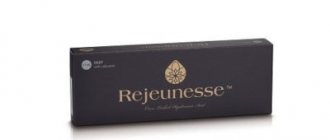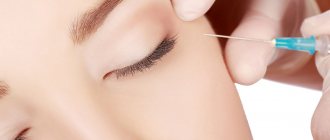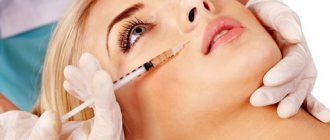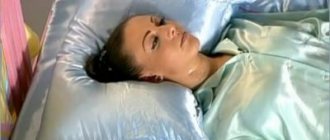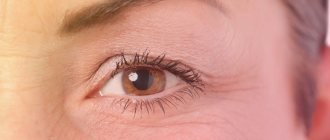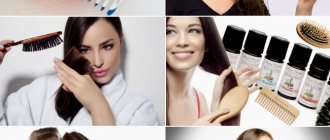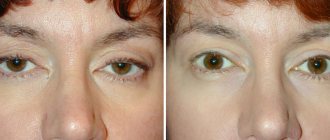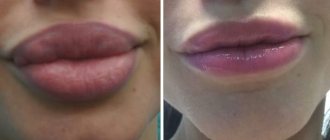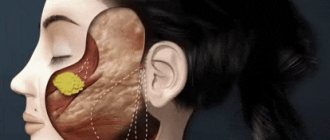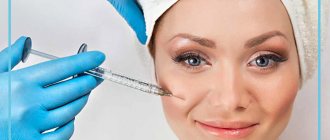Botox is a drug based on botulinum neurotoxin type A, which is produced by Allergan (USA). This word is also used to refer to all analogues of the drug. The botulinum toxin injection procedure gained popularity at the end of the last century and has since remained the most popular non-surgical anti-aging technique.
How Botox works
Botox injection is an effective technique for eliminating facial wrinkles and forming a beautiful facial contour. Essentially, this is a correction without a scalpel.
Botox is a weakened, purified neurotoxic drug based on botulinum toxin. The latter is produced by the bacteria Clostridium botulinum. A powerful neuroparalytic that can relax facial muscles.
Botulinum toxin A has been used in cosmetology for more than 30 years. It is injected into the area of the facial muscle, as a result it relaxes, and the skin relief of the area is noticeably smoothed. The hydrobalance of the deep layers of the dermis is restored, the natural production of collagen and elastin is stimulated.
Botox is used to correct facial contours, smooth out wrinkles on the forehead, in the eye area and nasolabial triangle.
Botulinum toxin: what is it and how does it help in the fight against wrinkles?
The effect of Botox is achieved due to the neurotoxin botulism type A. It is one of the most dangerous poisons in the world, but in cosmetology such microscopic doses of the substance are used that it is not at all difficult for a professional to control its effect and get a positive result.
Naturally, botulinum toxin is not used in cosmetology in its pure form. It is first stabilized and purified from protein impurities in the laboratory.
The effect of Botox is as follows: with an injection, it enters the muscle, blocking the transmission of nerve impulses in it. As a result, the muscle relaxes, its contraction stops, and as a result, the skin adjacent to it becomes smooth.
Exposure time
The duration of the effect of Botox depends on the individual characteristics of the body, habits, and care procedures:
- Age. Typically, botulinum therapy is indicated for people over 45 years of age, but often younger people also need correction. The breakdown of drug substances in a young body occurs faster, so the duration of the effect is reduced.
- Behavior. Poor nutrition, lack of sleep, stress and negative habits affect not only your well-being, but also your appearance - they worsen the effect of injections.
- Quality of the drug. The drug must be original and stored correctly.
Contraindications
Botulax is a new drug on the Russian market and has passed the necessary studies.
Main contraindications for injections:
- individual intolerance;
- diseases: diabetes, oncology, tuberculosis, infections, endocrine and cardiovascular, chronic pathologies;
- pregnancy and breastfeeding;
- problems with blood clotting;
- menstrual period;
- hernia of the eyelids;
- chronic muscle fatigue.
The choice of anti-aging injections will be made by a cosmetologist taking into account the condition of the skin, rejuvenation area, and age. It is difficult for a non-professional to make the right decision; choosing a drug is the task of a specialist.
Signs of Botox working
It is easy to feel the effect of botulinum toxin after the procedure: the facial muscles at the injection site stop working almost immediately, although a trace of the wrinkle will still be visible. For example, it will not be possible to frown your forehead, and, therefore, folds on the skin will not be able to form.
On days 5-7, the distribution of the drug ends, the effect becomes maximum: the skin is noticeably fresher, acquires a healthy shine and tint, and cosmetics fit perfectly on it. Even deep wrinkles are gradually smoothed out.
When administered correctly, Botox injections do not turn the face into a “mask.” There will still be facial expressions and emotions. To get truly excellent results, contact beauty centers - cosmetologists with extensive experience work there.
Correct dosage
Wherever toxin injections , it is important to correctly calculate the dose of the drug to achieve optimal effect. There is no need to do the calculations yourself - this is the task of an experienced cosmetologist in the clinic. The doctor will be able to determine the required amount of botulinum toxin only after an in-person examination and assessment of the patient’s skin condition.
The calculation takes into account:
- Age;
- Skin condition;
- Depth of wrinkles;
- Muscle activity;
- Condition of muscle tissue;
- Processing area;
- Number of injections.
However, there are average values for the required amount of botulinum toxin for different areas. The drug is measured in units. Knowing these values, you can very roughly calculate the cost of the procedure before visiting the clinic in order to have an idea of what to prepare for. Let's consider how many units may be required for different zones.
Repeated procedures
After Botox is removed, you can repeat the course to get the results back. Wait until your facial muscles have fully recovered to get the best results.
If Botox was administered for the first time, a corrective session is usually carried out after 8 months. All subsequent injections are performed at intervals of 4-6 months. With this technique you can maintain consistently good results.
If procedures are performed too often, the sensitivity of the dermis and nerve structures increases significantly. Botox dissolves faster each time, correction is required more often.
Drug manufacturers
The price of Botox injections to the forehead is determined taking into account the manufacturer of the drugs. The high-quality composition does not cause side effects, allergic reactions or other complications. Among the most popular and popular drugs are the following:
- Botox. Created by Allergan (USA). After administration, it relaxes the muscles by disrupting nerve conduction. The results last for about 6 months.
- Botulax. Produced by a South Korean cosmetology company. The drug is considered one of the most effective, safe, and is used for all parts of the face.
- Dysport. The drug was created by a French brand and is popular among patients and professional cosmetologists. The results of anti-aging therapy last for 4.5 – 5 months, the risks of side effects are minimized.
Is it possible to extend the result?
Follow all the cosmetologist's recommendations to get the maximum, safe and prolonged effect of the procedure.
We will consider the main recommendations below:
- Physical activity in the first 7-10 days after the session significantly reduces the effect of botulinum therapy.
- There are no additional jokes between the main courses! They will provoke the production of antibodies, which destroy the toxin and reduce its effect to a minimum.
- Avoid solariums, baths and saunas.
- Assess the compatibility of current pharmacotherapy with contraindications to botulinum therapy.
Injection safety
To avoid complications and side effects after botulinum therapy, before carrying out it it is important to pay attention to the following nuances:
- Take a responsible approach to choosing a clinic that provides this type of service, study the portfolio, and read real patient reviews.
- During the consultation, ask the cosmetologist for a license confirming his qualifications and professionalism.
- Pay attention not only to the manufacturer of the drug, but also study in detail the quality certificates, compliance with the batch number, and expiration dates.
The International Hemostasis Clinic employs experienced specialists who constantly improve their skills, undergo special training, and have the appropriate documents in hand. For botulinum toxin, our cosmetologists use only proven drugs, which guarantees the quality and safety of the service.
Lifestyle after the procedure
The strictest recommendations for the first 3 days after the session:
- Avoid alcoholic drinks: ethyl alcohol increases blood flow to the face.
- Do not take hot baths or go to the sauna.
- Avoid visiting the beach and solarium.
- Protect your face from direct sunlight.
- Avoid even minimal physical activity.
- Do not take muscle relaxants, tetracycline antibiotics, or B vitamins.
- Do not massage the injection area.
Precautionary measures
Like any other injection cosmetological rejuvenating technique, botulinum therapy has a list of contraindications, ignoring which is fraught with serious consequences. Botox injections are not prescribed to patients diagnosed with the following diseases:
- acute infectious diseases accompanied by general poor health, high temperature, fever;
- oncological neoplasms;
- herpes in the active stage;
- exacerbation of chronic diseases;
- cardiovascular disorders;
- cardiac, renal, liver failure;
- diseases of the hematopoietic system;
- autoimmune, hormonal, endocrine, nervous disorders;
- congenital or acquired immunodeficiency;
- damage to the integrity of the skin in places where injections are supposed to be given;
- diabetes.
Botulinum toxin injections are not prescribed for pregnant women, breastfeeding women, or during menstruation. The procedure is contraindicated for patients who are forced to constantly take medications that affect blood viscosity. Also, botulinum therapy is not carried out if a person has an individual intolerance to the components of the drug.
Undesirable effects
It is impossible to predict in advance how the substance will be distributed, how muscle fibers will react to the effects of botulinum toxin.
Typical side effects are redness of the facial skin, the appearance of papules, pain, and swelling.
Rare complications and their causes:
- Strong relaxation of the frontal muscles gives the effect of lowered eyebrows.
- Excessive botulinum toxin injections can lead to eyelid spasm.
- Excessive physical activity and ignoring recommendations are a common cause of asymmetry, bruising, and articulation disorders.
- Individual reaction: headaches, lumps and papules at injection points, increased intraocular pressure.
Comparative table of botulinum toxin composition
| Type of toxin/characteristics | Botox | Dysport | Xeomin | Lantox | Neuronox | Relatox |
| Units | 100 units | 500 units | 100 units | 50 and 100 units | 100 units | 50 and 100 units |
| Molecular mass | 900 kDa | 500 kDa | 150 kDa | 900 kDa | 900 kDa | 150 kDa |
| Albumen | 500 mcg | 125 mcg | 1 mg | — | 500 mcg | — |
| Excipients | NaCl 900 mcg | Lactose 2.5 mg | Sucrose 4.7 mg | Gelatin 5 mg Dextran 25 mg Sucrose 25 mg | NaCl 900 mcg | Gelatin 6 mg Maltose 12 mg |
Activity units reflect the dosage of drugs. One unit of activity corresponds to the average lethal dose (LD50) for female mice of average weight. Methods for determining activity units are individual and are not disclosed by manufacturers, so they are not equivalent to each other. It has been roughly established that 1 unit of Botox is almost equal in activity to 1 unit of Xeomin, Lantox, Neuronox and Relatox, and 3 units of Dysport. But once again I will emphasize that the equal sign cannot be used in this case. In practice, with equivalent administration of different drugs, different severity of effect and duration of action will be observed. This is also due to the fact that each batch of the drug may differ in activity by +/- 10%, which is reflected in the certificates provided by the manufacturer with each batch of toxins. Botulinum toxins are a biological product, which makes it difficult to standardize and store.
The particle size (molecular weight) of botulinum toxins will also differ (see table). The smaller the particle size, the greater the diffusion of the drug, the larger the area that can be “covered” with one injection. A high degree of diffusion in the hands of an inexperienced practitioner can lead to unwanted side effects due to the spread of the drug to adjacent muscles. On the other hand, this property provides a more uniform effect on the muscle, a “stronger” and faster effect.
Albumin is the main stabilizing substance. The functions of this protein are to bind botulinum toxin, limit the diffusion of the drug, and also limit its activity. The more albumin, the more subtly the drug works, and the “softer” its effect.
Excipients and their effect on the stability, diffusion and activity of drugs, unfortunately, are not described in the literature, which does not allow us to evaluate and accurately compare drugs with each other.
Advantages of the technique
The use of botulinum toxin injections in cosmetology has many advantages:
— This is the only method of rejuvenation that effectively blocks the muscles of the face and neck.
— A unique method allows you to eliminate the patient’s sweating for a long time.
— Botulinum toxin injections are painless, low-traumatic and do not require anesthesia.
— The procedure is carried out quite quickly and once, which saves the patient’s valuable time.
— The habit of not constantly using the facial muscles of the eyebrows and forehead can persist after the end of the effect, which will reduce the number of wrinkles.
— Botulinum toxin is the only cosmetic drug that is widely used in modern pediatrics
Advantages and disadvantages
The main advantages of the technique are:
- disappearance of pronounced facial wrinkles;
- correction of facial proportions;
- painlessness, safety;
- short period of rehabilitation;
- botulinum toxin is eliminated from the body naturally;
- the habit of not frowning on the upper part of the face becomes established.
The main disadvantage of the procedure is the short-term effect and the occurrence of an addictive effect. If injections are performed regularly, the immune system produces substances. Which neutralize the paralytic effect of Botox, so each subsequent time the results will be less noticeable.
